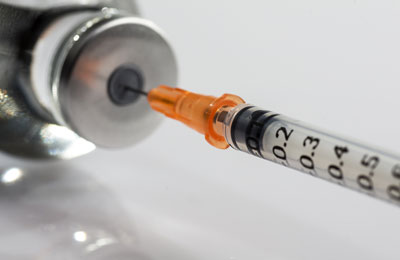
Safety-engineered syringes must be a priority, says WHO.
WHO calls for worldwide use of ‘smart’ syringes
GENEVA, February 23, 2015
Adoption of safety-engineered syringes is absolutely critical to protecting people worldwide from becoming infected with HIV, hepatitis and other diseases, said a top official of the World Health Organisation (WHO).
“This should be an urgent priority for all countries,” added Dr Gottfried Hirnschall, director of the WHO HIV/AIDS Department.
The new “smart” syringes WHO recommends for injections into the muscle or skin have features that prevent re-use.
Some models include a weak spot in the plunger that causes it to break if the user attempts to pull back on the plunger after the injection. Others have a metal clip that blocks the plunger so it cannot be moved back, while in others the needle retracts into the syringe barrel at the end of the injection
Syringes are also being engineered with features to protect health workers from “needle stick” injuries and resulting infections. A sheath or hood slides over the needle after the injection is completed to protect the user from being injured accidentally by the needle and potentially exposed to an infection.
WHO is urging countries to transition, by 2020, to the exclusive use of the new “smart” syringes, except in a few circumstances in which a syringe that blocks after a single use would interfere with the procedure. One example is when a person is on an intravenous pump that uses a syringe.
The organization is also calling for policies and standards for procurement, safe use and safe disposal of syringes that have the potential for re-use in situations where they remain necessary, including in syringe programmes for people who inject drugs. Continued training of health workers on injection safety – which has been supported by WHO for decades – is another key recommended strategy. WHO is calling on manufacturers to begin or expand production as soon as possible of ”smart” syringes that meet the Organization’s standards for performance, quality and safety.
“The new policy represents a decisive step in a long-term strategy to improve injection safety by working with countries worldwide. We have already seen considerable progress,” said Dr Edward Kelley, director of the WHO Service Delivery and Safety Department.
Between 2000 and 2010, as injection safety campaigns picked up speed, re-use of injection devices in developing countries decreased by a factor of 7. Over the same period, unnecessary injections also fell: the average number of injections per person in developing countries decreased from 3.4 to 2.9. In addition, since 1999, when WHO and its partner organizations urged developing countries to vaccinate children only using syringes that are automatically disabled after a single use, the vast majority have switched to this method.
Syringes without safety features cost $ 0.03 to 0.04 when procured by a UN agency for a developing country. The new “smart” syringes cost at least twice that much. WHO is calling on donors to support the transition to these devices, anticipating that prices will decline over time as demand increases. – TradeArabia News Service







